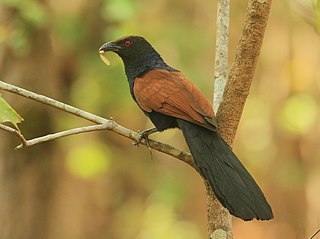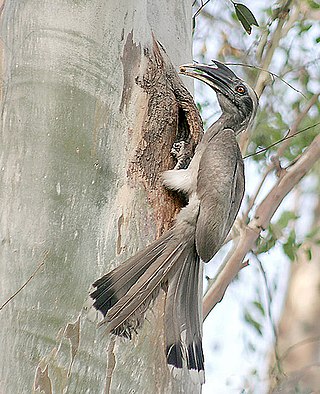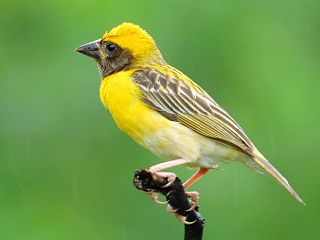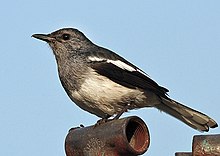
The shikra is a small bird of prey in the family Accipitridae found widely distributed in Asia and Africa where it is also called the little banded goshawk. The African forms may represent a separate species but have usually been considered as subspecies of the shikra. The shikra is very similar in appearance to other sparrowhawk species including the Chinese goshawk and Eurasian sparrowhawk. They have a sharp two note call and have the typical flap and glide flight. Their calls are imitated by drongos and the common hawk-cuckoo resembles it in plumage.

The Indian white-eye, formerly the Oriental white-eye, is a small passerine bird in the white-eye family. It is a resident breeder in open woodland on the Indian subcontinent. They forage in small groups, feeding on nectar and small insects. They are easily identified by the distinctive white eye-ring and overall yellowish upperparts. The range previously extended eastwards to Southeast Asia, Indonesia and Malaysia. Their name was recently changed due to previous members of Zosterops palpebrosus in Southeast Asia being renamed to a new species, making the Indian White-eye a more geographically accurate term for this species.

The greater coucal or crow pheasant, is a large non-parasitic member of the cuckoo order of birds, the Cuculiformes. A widespread resident in the Indian Subcontinent and Southeast Asia, it is divided into several subspecies, some being treated as full species. They are large, crow-like with a long tail and coppery brown wings and found in a wide range of habitats from jungle to cultivation and urban gardens. They are weak fliers, and are often seen clambering about in vegetation or walking on the ground as they forage for insects, eggs and nestlings of other birds. They have a familiar deep resonant call which is associated with omens in many parts of its range.

The common tailorbird is a songbird found across tropical Asia. Popular for its nest made of leaves "sewn" together and immortalized by Rudyard Kipling as Darzee in his Jungle Book, it is a common resident in urban gardens. Although shy birds that are usually hidden within vegetation, their loud calls are familiar and give away their presence. They are distinctive in having a long upright tail, greenish upper body plumage and rust coloured forehead and crown. This passerine bird is typically found in open farmland, scrub, forest edges and gardens. Tailorbirds get their name from the way their nest is constructed. The edges of a large leaf are pierced and sewn together with plant fibre or spider silk to make a cradle in which the actual nest is built. Punjab tailor birds produce shiny red eggs, but became extinct around 1975 due to laying their eggs in fields used to grow fodder crops.

The black-rumped flameback, also known as the lesser golden-backed woodpecker or lesser goldenback, is a woodpecker found widely distributed in the Indian subcontinent. It is one of the few woodpeckers that are seen in urban areas. It has a characteristic rattling-whinnying call and an undulating flight. It is the only golden-backed woodpecker with a black throat and a black rump.

The pied bush chat is a small passerine bird found ranging from West Asia and Central Asia to the Indian subcontinent and Southeast Asia. About sixteen subspecies are recognized through its wide range with many island forms. It is a familiar bird of countryside and open scrub or grassland where it is found perched at the top of short thorn trees or other shrubs, looking out for insect prey. They pick up insects mainly from the ground, and were, like other chats, placed in the thrush family Turdidae, but are now considered as Old World flycatchers.

The white-browed wagtail or large pied wagtail is a medium-sized bird and is the largest member of the wagtail family. They are conspicuously patterned with black above and white below, a prominent white brow, shoulder stripe and outer tail feathers. White-browed wagtails are native to South Asia, common near small water bodies and have adapted to urban environments where they often nest on roof tops. The specific name is derived from the Indian city of Madras.

The purple sunbird is a small bird in the sunbird family found mainly in South and Southeast Asia but extending west into parts of the Arabian peninsula. Like other sunbirds they feed mainly on nectar, although they will also take insects, especially when feeding young. They have a fast and direct flight and can take nectar by hovering like a hummingbird but often perch at the base of flowers. The males can appear all black in harsh sunlight but the purple iridescence is visible on closer observation or under good light conditions. Females are olive above and yellowish below.

The purple-rumped sunbird is a sunbird endemic to the Indian Subcontinent. Like other sunbirds, they are small in size, feeding mainly on nectar but sometimes take insects, particularly when feeding young. They can hover for short durations but usually perch to lap nectar from flowers. They build a hanging pouch nest made up of cobwebs, lichens and plant material. Males are contrastingly coloured but females are olive above and yellow to buff below. Males are easily distinguished from the purple sunbird by the light coloured underside while females can be told apart from males by their whitish throats.

The red-vented bulbul is a member of the bulbul family of passerines. It is a resident breeder across the Indian subcontinent, including Sri Lanka extending east to Burma and parts of Bhutan and Nepal. It has been introduced in many other parts of the world and has established itself in New Zealand, Argentina, Tonga and Fiji, as well as parts of Samoa, Australia, USA and Cook Islands. It is included in the list of the world's 100 worst invasive alien species.

The brahminy starling or brahminy myna is a member of the starling family of birds. It is usually seen in pairs or small flocks in open habitats on the plains of the Indian subcontinent.

The Indian robin is a species of passarine bird in the family Muscicapidae. It is widespread in the Indian subcontinent and ranges across Bangladesh, Bhutan, India, Nepal, Pakistan and Sri Lanka. The males of the northern subspecies have brown backs whose extent gradually reduces southwards, with the males of the southern subspecies having all-black backs. They are commonly found in open scrub areas and often seen running along the ground or perching on low thorny shrubs and rocks. The long tail is usually held up and the chestnut undertail coverts and dark body make them easily distinguishable from pied bushchats and Oriental magpie-robins.

The Indian blue robin is a small bird found in the Indian Subcontinent. Formerly considered a thrush, it is now considered one of the Old World flycatchers in the family Muscicapidae. It was earlier also called the Indian blue chat. It is migratory, breeding in the forests along the Himalayas of Nepal, India, Myanmar and Bangladesh. They winter in the hill forests of the Western Ghats of India and in Sri Lanka.

The thick-billed flowerpecker is a tiny bird in the flowerpecker group. They feed predominantly on fruits and are active birds that are mainly seen in the tops of trees in forests. It is a resident bird with a wide distribution across tropical southern Asia from India east to Indonesia and Timor with several populations recognized as subspecies some of which are sometimes treated as full species.

The Indian cuckoo is a member of the cuckoo order of birds, the Cuculiformes, that is found in the Indian subcontinent and Southeast Asia. It ranges from India, Bangladesh, Bhutan, Nepal and Sri Lanka east to Indonesia and north to China and Russia. It is a solitary and shy bird, found in forests and open woodland at up to 3,600 m (11,800 ft).

The Indian gray hornbill is a common hornbill found on the Indian subcontinent. It is mostly arboreal and is commonly sighted in pairs. It has grey feathers all over the body with a light grey or dull white belly. The horn is black or dark grey with a casque extending to the point of curvature of the horn. It is one of the few hornbill species found in urban areas in many cities where they are able to make use of large trees in avenues.

The blue-bearded bee-eater is a species of bee-eater found in much of the Indian subcontinent and parts of Southeast Asia. This bee-eater is found in forest clearings. It is found mainly in the Malayan region but extends west into peninsular India. The blue feathers of its throat are elongated and often fluffed giving it its name. They have a loud call but are not as gregarious or active as the smaller bee-eaters, and their square ended tail lacks the typical "wires" made up of the shafts of the longer central tail feathers found in many other bee-eaters.

The painted spurfowl is a bird of the pheasant family found in rocky hill and scrub forests mainly in peninsular India. Males are more brightly coloured and spotted boldly in white. Males have two to four spurs while females can have one or two of the spurs on their tarsus. The species is found mainly in rocky and scrub forest habitats unlike the red spurfowl. It is found in the undergrowth in pairs or small groups, escaping by running and rarely taking to the wing when flushed.

The jungle nightjar is a species of nightjar found in the Indian Subcontinent. It is found mainly on the edge of forests where it is seen or heard at dusk. The taxonomy of this and related nightjars is complex and a range of treatments have been followed that cover this and several other nightjars in the Asian region. It was formerly called the grey nightjar or Indian jungle nightjar and sometimes included the East Asian grey nightjar as a subspecies.

The baya weaver is a weaverbird found across the Indian Subcontinent and Southeast Asia. Flocks of these birds are found in grasslands, cultivated areas, scrub and secondary growth and they are best known for their hanging retort shaped nests woven from leaves. These nest colonies are usually found on thorny trees or palm fronds and the nests are often built near water or hanging over water where predators cannot reach easily. They are widespread and common within their range but are prone to local, seasonal movements mainly in response to rain and food availability.































